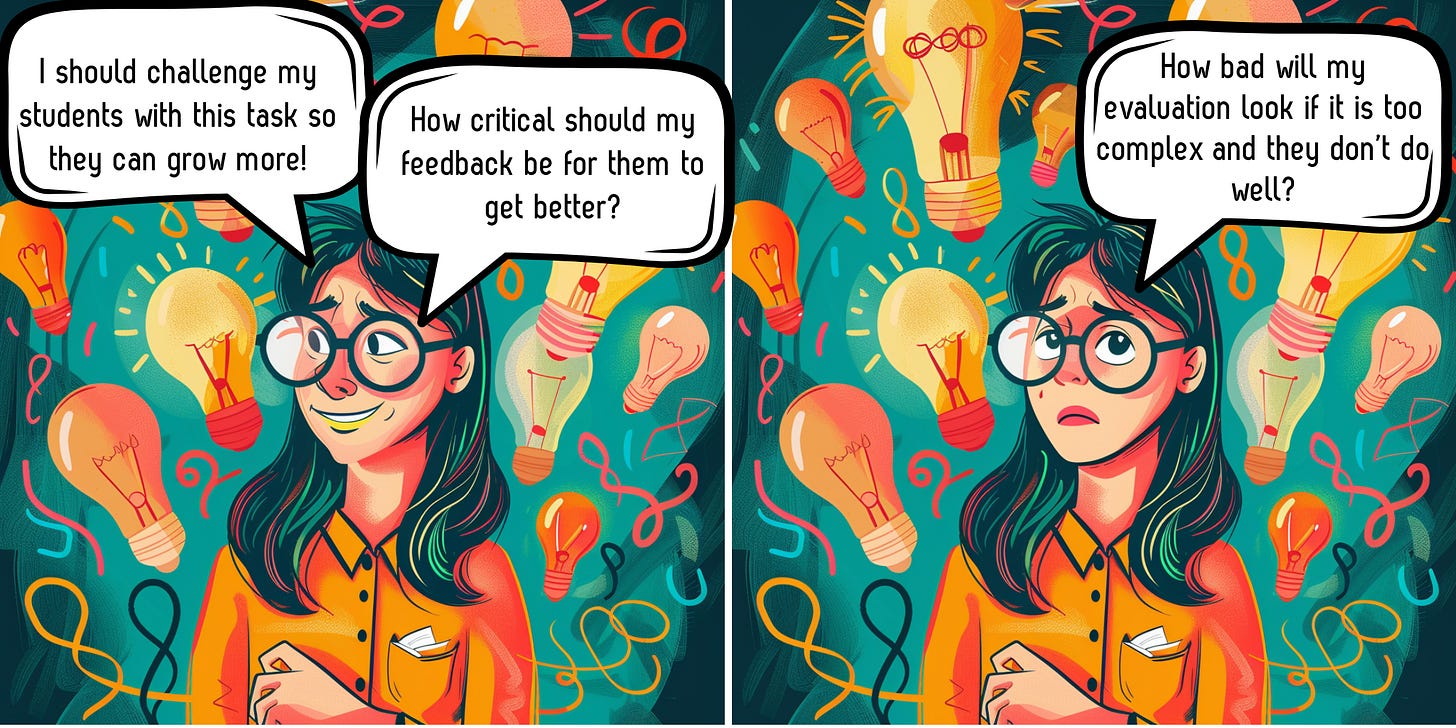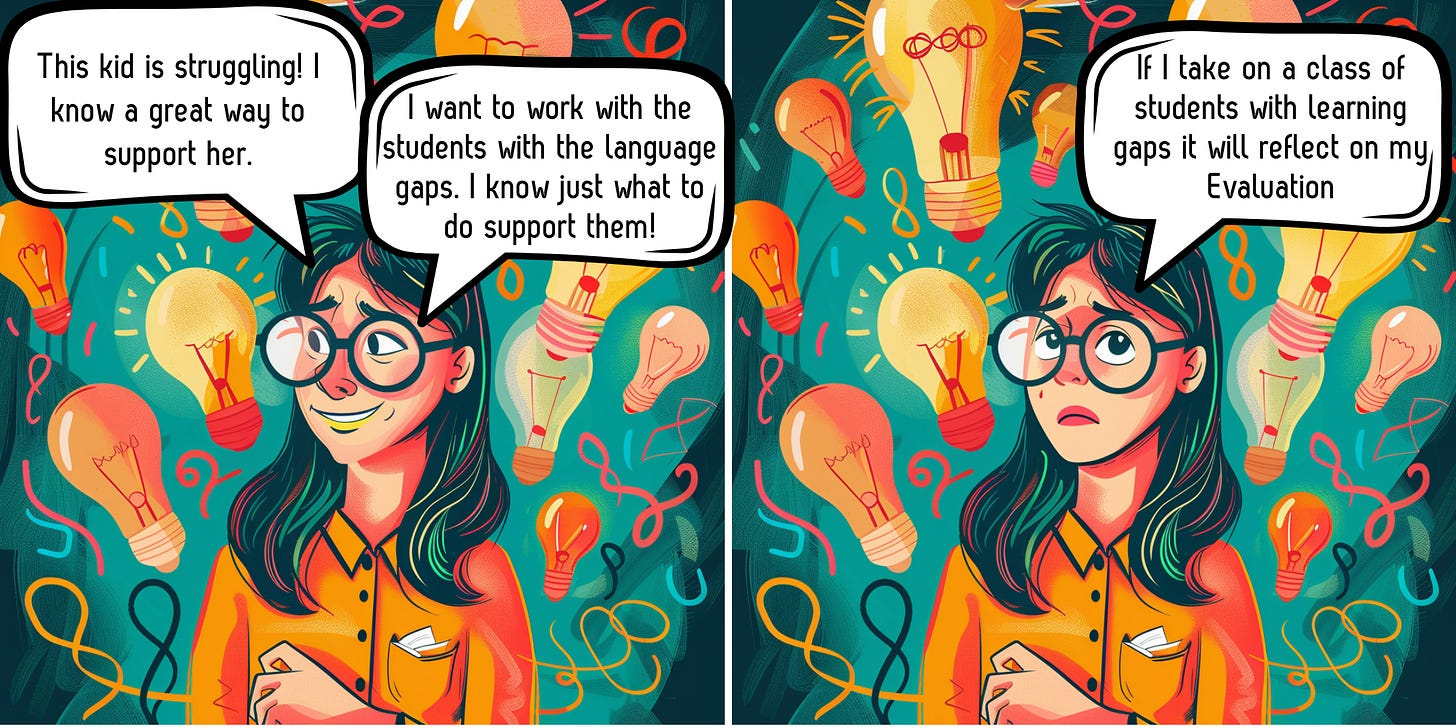The Unintended Consequences of Teacher Evaluation
Influences every leader needs to be aware of
In a nutshell:
Teacher Evaluation can provide important insights for School Systems that aim to improve.
But practically, Teacher evaluation is complex and often results in unintended consequences. These consequences can include (1) creating unnecessary conflicts and ethical dilemmas for teachers between fostering student learning and achieving high performance metrics; (2) Disincentivizing the support for students with greater learning gaps (3) fostering a fearful environment that stifles creativity and innovation
Approaches to consider while designing Teacher Evaluation Systems
(1) Focus on improvement and not just accountability (2) Create comprehensive systems that reflect the complexity of teaching (3) Implement evaluation systems with support mechanisms (4) Maintain an unwavering commitment to serving students by recognizing when the teacher evaluation system starts to work against this goal and adjust accordingly
Last year I wrote this post on ‘The Cobra Effect of Board Exams’. I talked about the unintended consequences of the Board Exams i.e. centralized student evaluation. These unintended consequences are that board exams lead to schools teaching the test, which restricts what students learn, which eventually leads to less relevant, more shallow student learning. Which is the opposite of the goals being targeted in the first place.
Today I am going to extend that idea to Teacher Evaluation.
A teacher who cheated for her students
Many years ago, one of my Instructional Leaders requested to meet with me. When I got to her room, I found her sitting behind a stack of exam papers with a look of shock on her face.
She had been moderating exam papers i.e. randomly reviewing a few student exam answer sheets from different classes. These papers were already graded by different teachers, and she was checking for consistency in the grading. While doing this, she noticed that one of the papers had student work in two different blue inks and inconsistent handwriting. She pulled out a few more papers, only to discover that about 70% of the papers in that one class showed this discrepancy. Each of those papers had parts of their answers completed in a different blue ink and in a slightly different handwriting. It was so odd.
This sent her into full detective mode. At some point in her investigation she realized that the teacher’s notes, which were handwritten in red ink, matched a part of student work, which was in blue ink. The logical conclusion of this would be that the teacher had intentionally modified student responses with blue ink. This is when she called me and I walked in to find her in disbelief. After she explained this to me, I was stunned too.
After conversations with that teacher, sadly our deductions were confirmed to be true. The teacher had actually edited student answers in blue ink so they would perform better on the exam. She felt that her performance was linked to the performance of students. So in a lapse of good judgment, she chose to cheat and inflate their grades to make the performance of her students look better.
This was just depressing to witness. Yes it was a clear ethical violation. But at the same time, this novice teacher had so much potential - she was passionate about teaching and was eager to try new strategies in the classroom.
And somehow she felt she had to choose this route to ‘prove’ her teaching competence. She had completely misunderstood the purpose of reviewing data i.e. as a learning tool to improve our teaching practices and improve student learning. Instead she interpreted her student data to be a stamp of judgment - a permanent mark on her own report card.
And she had completely lost sight of the one goal that drives all our decisions at school - helping students learn.
This incident saddened me and left me scarred. It really got me thinking about the messaging that teachers get from the systems that we leaders set up.
Unintended Consequences of Teacher Evaluation
The Purpose of Teacher Evaluation:
The purpose of Teacher evaluation is to support teacher performance and development which should improve student learning.
This makes great sense in theory, but in reality, there can be many unintended consequences when implementing this plan.
Teaching is a Complex Skill and so Teacher Evaluation is Complex too:
Teaching is a complex skill that involves content knowledge, pedagogical knowledge, instructional skills and social emotional skills. It is also situational, which means the ‘right’ strategy will be different depending on the context.
Therefore, evaluating teaching and teachers is complicated.
Teacher Evaluation and 3 Unintended Consequences
Using student data to evaluate teacher competence
If the key role of teachers is to develop students, why can’t we just tie teacher competence to the performance of their students?
We need teachers to do the ‘measuring’ of student learning. This is because
Student learning (academic, socio-emotional, 4Cs etc.) is complex and
Student learning data is used to improve the learning process for teachers and students.
So it is most effective when measured by the person teaching and spending most time with the students.
Unintended Consequence #1: Growth or Good Grades?
One major unintended consequence is that this system can create a conflict of interest with student assessment.
Should the teacher give students challenging work that promotes growth and risk a lower average grade OR Should the teacher just assign easy work that guarantees higher student grades but doesn’t enable as much learning for students.
When we tie student learning data to the performance of teachers, we create situations where they are asking ‘How will I be judged based on my students' data?’ instead of ‘How can I use this data to improve their learning and my teaching?
This could also explain the motive behind the teacher’s unsound judgment in my story above. She lost sight of the purpose of student assessment. Instead of using it for improving teaching and learning she viewed it as a judgment of her ability.
Unintended Consequence #2: Growth or ‘Good’ students?
Another unintended consequence is that the system creates incentive for teachers to only want star performers in their class. If I know I will be judged by the results of my students, what incentive do I have to take on students who are struggling or with additional learning needs?
You might argue that we need teachers to have strong ethics and values. Yes that is true. And a great majority of teachers do. But it is poor system design if it creates an obvious conflict on interest like this.
2. Using ‘Teaching’ as a Measure of Teacher Competence
Teaching is a complex skill, and we can’t measure it just by doing some simple assessments for knowledge. Today the best way to do this by conducting teacher observations.
For years I have witnessed teacher observations, from both leaders and peers, having one of the greatest positive impacts on teacher competency. With the right culture, even novice teachers welcome observations of their classes.
Of course, when humans conduct observations for the purpose of evaluation there are two known drawbacks - 1) It is extremely time-consuming 2) It is hard to standardize the evaluations of different human observers. Both of these make this approach hard to scale successfully.
Unintended Consequence #3: Innovation or Compliance?
However one unintended consequence is the negative psychological and cultural impact of ‘observations for evaluation’. If observations are conducted for the purpose of evaluation only - often as surprise visits, the team can develop a hostility towards classroom observations. It becomes a source of anxiety, the observer becomes the ‘judge’ instead of a ‘supporter’ and the process becomes about maintaining a scorecard instead of learning and improvement.
Often, this permeates into the culture which shifts focus from learning, inspiration and innovating to a fearful one of compliance.
What do we do?
Do we ditch teacher evaluation? No. Teacher evaluation is an important part of systemic school improvement. We cannot improve at scale what we cannot measure (Bryk). It provides the school and teachers with feedback on teaching, so that both can get better. All in service of Students.
But it does need to be built on a strong ‘Culture of Learning’.
Everyone in the system must remember that the ultimate goal of all our efforts, including Teacher Evaluation, is to ‘Improve Student Learning’
We need to resist the urge to reduce teacher performance to just numbers.
We need to be aware of the limits of standardizing the evaluation of a skill that is highly situational.
How do we build both together - Teacher Evaluation Systems AND a Culture of Learning?
This question has definitely been explored by educational experts. Here are two that echo my sentiment, though in a US context.
“Teacher evaluation systems are being overhauled by states and districts across the United States. And, while intentions are admirable, the result for many new systems is that good--often excellent--teachers are lost in the process. In the end, students are the losers.” - Getting Teacher Evaluation Right: What Really Matters for Effectiveness and Improvement, Linda Darling-Hammond
“Educational evaluation (Ed Eval) and professional learning communities (PLCs) are two of the nation’s most predominant approaches to widespread instructional improvement. Yet key attributes of these reform initiatives are too often experienced by teachers as burdensome, or even detrimental, rather than helpful.” - Beyond Hammers Versus Hugs: Leveraging Educator Evaluation and Professional Learning Communities Into Job-Embedded Professional Development, Woodland and Mazur
Approaches to consider while designing Teacher Evaluation Systems
Here is some inspiration from experts above that I use while thinking about solutions to this challenge:
Focus on Improvement and not just Accountability.
The ultimate purpose of data is not to serve as a rank or judgment.
It should be viewed more as a diagnostic that provides information about (1) areas of strengths that should be replicated and (2) improvement that should be worked on
Design Comprehensive Systems that reflect the complexity of teaching:
Resist the urge to reduce everything to numbers.
Create evaluations systems that include participatory approaches and a range of data points like portfolios, peer reviews to demonstrate teacher competencies
Implement Systems for Evaluation with Systems for Support
Use the data to determine what kind of support people need. And then find ways to provide it.
Include frequent, development-focused conversations in the process
Ensure an unwavering commitment to serving students
Recognize when the teacher evaluation system starts to work against this goal and adjust accordingly (The purpose of a system is what it does, not what it claims to do. - Stafford Beer)
On a related note, this is a dilemma that may extend beyond education. Here’s an HBR article that I read a few years ago. It echoes a similar sentiment. A quote from the article “The annual review’s biggest limitation, the authors argue, is its emphasis on holding employees accountable for what they did last year, at the expense of improving performance now and in the future”







With the exception of 360-degree assessments – and they are not really 360 - evaluation in most organisations is top-down. Conceptually this is flawed because evaluation should emanate from the people that the product/service/person affects the most and in education that is obviously the students.
It’s perplexing that during the period when my three children were in formal education, not once were they asked their opinion about the school or the teachers.
In business the ethos of customer-obsession or customer-centricity is robust because everything is a by-product of the customer experience. Swap in “student” for customer so that school evaluation systems, including those ot teachers, innovation and operations are driven by the holistic student experience.
In other words, be obsessed with the holistic student experience then reverse engineer.